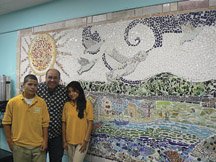Students eating lunch in the cafeteria of Ezra L. Nolan Middle School 40 in the Greenville section of Jersey City get to enjoy fine art at the same time.
That’s due to the 14 mosaics that cover much of the lunchroom and the adjoining hallway in the school’s basement.
The mosaics, which are wall-sized artworks made of colored glass tiles and stones, were created by 46 of the school’s students from the sixth, seventh and eighth grades under the guidance of art instructor Luis DeJesus. The project took about two years and was completed earlier this month.
The images in the mosaics are of places with people dancing and rivers flowing with local landmarks such as the Statue of Liberty in the background, and they reflect the ethnic and cultural backgrounds of the students who attend the school.
“Every day, it’s like walking into an art museum, it’s that impressive.” – Ana Rivas
________
“Inner city kids like the ones here at this school have such a love for the arts,” DeJesus said. “I am so proud of them, and it is still such a joy to see their work.”
Eighth graders Wilkins Candelaria and Nazuki Poso also were pleased with the work they had accomplished.
Poso said she liked taking part in the project.
“I enjoyed doing a lot of drawing, designing and putting the tiles together,” Poso said. “And we discovered that we all share one language, which is art.”
Candelaria said he thought the experience was just going to be learning about woodcutting, but it turned out to be much more.
“When I saw what this was, I said, ‘Whoa,’” Candelaria said. “It was about cutting and pasting tiles … I love it and I like what I have done since we worked as a team.”
Walls that talk
DeJesus called the mosaics “walls that talk” since they express the personal visions and experiences of the students.
“We wanted kids to experience art at a level that is exquisite and masterful, and empowers them to see the best in themselves,” DeJesus said.
DeJesus said the project started with the students drawing images and designs, what he called a “rehearsal.”
Next, the colored tiles were cut to shape. Then, the students took the colored tile pieces and colored stones and glued them onto the walls of the school’s cafeteria and hallways. This process would happen three to four days a week, after school, for up to three hours a day.
Nazuki Poso’s mosaic came out of her upbringing in a Peruvian village, with Japanese icons that reflect her heritage as a native of Peru with Spanish and Japanese roots. The experience of creating such personal artwork and sharing it with her classmates still resonates with her.
“We had a purpose to beautify the school but also it was to show the beauty of the different cultures where we come from,” Poso said.
And it was not just students who had input in the project.
The school’s principal, Ana Rivas, said the project was a “school-wide” endeavor where workers in the school gave ideas for what should be shown in the mosaics, and contributed the materials that were used.
Rivas also saw the creation of the mosaics as an effort that joined the children together.
“To me, the main purpose was to bring them together in some type of activity where they would get to know each other and be accepting of one another,” Rivas said. “We have kids in the bilingual classes, who are limited English speakers and those in the general population who are from different countries such as Pakistan and Haiti.”
Rivas also called the work “amazing.”
“Every day, it’s like walking into an art museum, it’s that impressive.”
Ricardo Kaulessar can be reached at rkaulessar@hudsonreporter.com.
